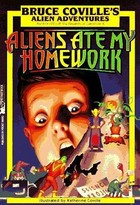Short review: Someone is feeding stories to the newspapers about Pleskit. Everyone suspects Tim and Pleskit thinks its a good idea to bring his grandfather's disembodied brain to school.
Haiku
Newspaper stories
Prompt some ill-advised actions
A brain is stolen
Full review: I Lost My Grandfather's Brain is the third book in Bruce Coville's I Was a Sixth Grade Alien series. Like the previous books in the series, the story is told in an alternating viewpoint format with the alien sixth grader Pleskit and his human friend Tim narrating alternate chapters. As usual for a Coville book, there is a certain amount of editorializing about the superior nature of alien society, but it is not too heavy-handed.
Like most of the books in the series, the main plot element is given away by the title of the book, so it should surprise no one that Pleskit loses his grandfather's brain. Those who have read the earlier books in the series know that Pleskit's grandfather, or in alien vernacular "grandfatherly one" is a disembodied brain kept alive in a vat of chemicals. Stories clearly based on inside information obtained from someone at school featuring Pleskit begin turning up in a tabloid, prompting Pleskit to seek the advice of his grandfather. His grandfather, annoyed at being cooped up inside the alien embassy and ignored, helpfully suggests that Pleskit take him to school and let him try to figure out who has been leaking information to the press.
Adding further complications to the story line, circumstances result in suspicion falling upon Tim as the information source for the newspaper articles, driving something of a wedge between Tim and Pleskit. Because of the shifting viewpoint form of storytelling we know that Tim did not actually betray his friend, but we do see Pleskit's more or less understandable doubts come into play. Seeing things from Tim's perspective as well gives us a window into his confusion and frustration as he struggles to find a way to clear his name and reassure his best friend that he didn't sell him out for a quick buck. During their estrangement, Pleskit engages in a somewhat odd quasi-friendship with Jordan, the class bully who had spent the previous two books pushing Pleskit and Tim around. This storyline lets Coville address one of his favored "messages" as Pleskit is able to learn a little bit about the value of true friendship as opposed to phony friendship.
The series of unwelcome newspaper articles featuring Pleskit allows Coville to do his usual moralizing about the superiority of alien society as Meenom (Pleskit's "fatherly one") is outraged to discover that on Earth (or at least in the United States) there is no restriction on printing newspaper articles about children. One might consider such a restriction to be a good idea, but all of the human characters at hand feebly talk about their helplessness to change the law, but no one offers any kind of defense of the idea of freedom of the press. As seems fairly typical, Coville has a bone to pick with modern society and sets up a strawman to attack. I'm not saying Coville's position on this issue is obviously wrong, and I'm not saying he's right either, but one would think Coville would make a better case for his position if he treated the opposing arguments more seriously than he does. On the other hand, this is a book aimed at young readers. That said, I don't really think that is an excuse for doing little more than painting a caricature of the other side and knocking it down.
To solve the mystery of who is sending stories to the newspapers, Pleskit brings his grandfather to school, who proves to be a big hit among his classmates. Unfortunately, during a bomb scare, the container holding Pleskit's grandfather is left in the classroom, and then stolen. Through a series of events the Grandfatherly One's brain is recovered and the newspaper source is uncovered while both the Grandfatherly One and Tim prove to be heroes in their own fashion and everything turns out well. In typical Coville fashion, the story has a lot of action, a little intrigue, and some moral lessons about friendship and the superiority of non-human civilization. In short, any young reader who likes science fiction will probably have a good time if he opens the pages of this book.
Previous book in the series: I Was a Sixth Grade Alien: The Attack of the Two-Inch Teacher
Subsequent book in the series: I Was a Sixth Grade Alien: Peanut-Butter Lover Boy
Bruce Coville Book Reviews A-Z Home










